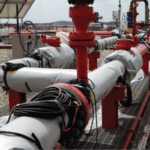As industrial process experts, we understand the importance of maintaining a consistent pipeline temperature. Industries in cold climates can lose thousands of dollars daily due to sub-zero temperatures causing frozen pipes, valves, and instrumentation.
The flow of fluids in a pipeline is crucial to the success of any industrial process. Freezing pipes can cause significant damage and costly downtime. When sections of piping freeze, it can halt a portion of the production line or cause a complete factory shutdown.
At what temperature do pipes freeze? You’re about to find out.
We’ll discuss the basics of pipes freezing, the dangers, prevention, and how to thaw them safely. The article will highlight the importance of temperature control in industrial processes.
Understanding the Basics of Pipe Freezing
Like most substances, when liquid water cools, the molecules contract and become denser. However, when water reaches approximately 39°F (4°C), the hydrogen molecules begin to align, creating more space and making the water molecule less dense. This phenomenon is why ice floats on water.
Water expands by about 9% when it freezes. This molecular expansion creates tremendous pressure inside the pipe until it ruptures.
The Dangers of Frozen Pipes
Washington, DC, is not known for severe winter weather, but hard freezes occur. One fancy French restaurant near Dupont Circle was 30 minutes from serving lunch to an upscale clientele. The previous night was brutally cold. Neither the retrofitted mansion nor the pipes had any insulation.
The copper water supply lines to the dish machine had frozen and cracked the pipes in many places. As the heat from the kitchen thawed the pipes, water started to spray everywhere.
Then the unthinkable happened. The 3-inch steel pipe holding water for the fire sprinkler system thawed and gave way. Three floors of water gushed over the entire serving line like Niagara Falls, destroying business for that day.
Frozen pipes can significantly impact your business, leading to costly repairs, production downtime, and even safety hazards.
When pipes freeze and burst, they can cause water damage to your building and equipment, leading to expensive repairs and cleanup. In addition, production downtime can be a significant issue, as you may have to shut down operations until the pipes are repaired or replaced. This can lead to lost revenue and potentially damage your reputation with customers.
Frozen pipes can also pose safety hazards to your employees. Water can flood your building from a burst pipe, ruining equipment and inventory, creating slippery surfaces and potential electrical risks. Over time, if not adequately cleaned up, mold and other harmful bacteria can grow.
If you operate where freezing weather occurs, consider custom pipe heating solutions to prevent frozen pipes. It can be less costly than relocating piping or insulating an existing building.
Common Causes of Frozen Pipes
As we’ve seen, freezing air can seep into your building through walls and gaps in doors and windows. Retrofitted buildings are especially susceptible.
Exposed pipes in unheated areas like attics, basements, and crawl spaces, have a high risk of freezing even if insulated. A long-term cold snap will eventually defeat the pipe insulation, especially if the water is not flowing.
Other common causes of frozen pipes include inadequate heating in the building and a lack of insulation either in the walls or on the pipes.
At What Temperature Do Pipes Freeze?
Although water freezes at 32°F (0°C), a pipe won’t freeze until the ambient temperature drops to 20°F (-6.6°C) or lower. Once the heat in the water radiates through the pipe wall, it begins to freeze.
The pipe’s freezing temperature can vary depending on its location and the amount of insulation it has.
How Quickly Can Pipes Freeze
In general, pipes will freeze faster if they are located in unheated areas or not adequately insulated. If the water is not moving, it will freeze more quickly than if it is flowing steadily.
Small pipes such as ½ inch copper with some insulation will freeze solid in about 6 hours at 20°F (-6.6°C). Uninsulated pipes can freeze in about 3 hours.
At What Temperature Do Pipes Burst?
Although various pipes have different burst pressure points, ice exerts massive force below 20°F (-6.6°C). However, pipes without proper insulation may burst at a higher temperature due to previously mentioned factors. Here are a few pipe bursting pressures depending on the material:
- A ¾ inch Type K copper pipe, the strongest, has a working pressure of 1,466 psi.
- A 2-inch PVC schedule 40 pipe bursts at 890 PSI and Schedule 80 pipe bursts at 1,290 PSI.
- By contrast, a 2-inch wrought steel pipe has a bursting pressure of 5,185 psi.
That sounds like a lot, but the freezing force of water is about 25,000 psi and can go up to 114,000 psi. Any pipe is no match for expanding ice.
Temperature Control for Industrial Pipe Systems
Advanced heating options, such as heating blankets or heat tracing, are crucial for preventing frozen pipes. To control the temperature, a reliable and accurate thermostat is vital when maintaining the right temperature for your pipes. Using a thermostat can ensure that your pipe system stays within the desired temperature range, helping to prevent freezing and other damage.
At what temperature do pipes freeze in a house or commercial space? It’s a trick question. Water freezes at the same temperature, 32°F (0°C). If the house has enough heat and the pipes are inside the heated area, they will never freeze.
How to Prevent Frozen Pipes
You can combine several strategies to prevent frozen pipes, including:
- Insulation: Proper insulation can slow the rate of heat loss in the pipe.
- Heat the building: Maintaining a consistent temperature inside the building where pipes run will prevent them from freezing.
- Pipe heat tracing: Maintain a consistent internal temperature with heat tape for pipes. Unlike insulation, heat trace or heat tape radiates heat directly to the pipe’s surface, preventing freezing internally.
- Maintain walls and windows: Sealing gaps or cracks in your building is essential to prevent freezing air from entering and affecting nearby pipes.
- Relocate if possible: consider relocating pipes in unheated areas to a warmer location.
- Drain any unnecessary pipes: If you have water pipes next to walls that allow freezing temperatures, drain all water from the lines you don’t need before the freezing weather starts.
Invest in temperature monitoring equipment to track the temperature inside commercial buildings and warehouses subject to freezing temperatures. Doing so gives you time to heat the area before it becomes problematic.
Heat Trace is the most common pipe heating solution and freeze prevention measure for industrial applications. However, if switched off, a heat trace or heat tape can take a long time to thaw a frozen pipe. Their purpose is to maintain temperatures, not to thaw pipes.
A better solution to thaw a frozen pipe is a pipe heating blanket. Heating blankets heat up to 90°F (32°C), safely solving freezing pipe issues.
When to Call a Professional for Frozen Pipe Bursts
If your pipes freeze and the water doesn’t flow for more than two hours, it’s time to call a plumber. If the pipe thaws and bursts, call a plumber immediately.
Act quickly to minimize the damage. Immediately turn off the water supply. Try to find the frozen section by looking for frost outside the pipe or feel if one area is colder.
A professional plumber will assess the damage, thaw the pipe and make any necessary repairs. Attempting to thaw your pipes using an open flame heat source like a blowtorch can cause further damage to your pipes and possibly burn down the building. Let a pro take care of it to avoid unnecessary damage.
However, read these tips first if you plan to thaw pipes yourself.
Tips for Thawing Frozen Pipes Safely
If your pipes do freeze, it’s important to thaw them safely to prevent further damage. Some tips for safely thawing frozen pipes include:
- Use a hand-held dryer or heating pad to thaw the pipes slowly.
- Once thawed, insulate the pipes to prevent further freezing, even if you only have towels or blankets to help retain heat.
- Use a forced fan space heater to blow hot air onto the pipe.
- Use a heat lamp if thawing a small section.
- NEVER use an open flame like a blowtorch to thaw your pipes. They can cause a fire to the surrounding paint, wiring, or materials and can cause more damage to your pipes.
Bring the heat with a pipe heater or pipe wrap for long-term freeze protection down to -40°F (-40°C). Pipe heaters can be installed and uninstalled as needed.
At What Temperature Should You Drip Faucets?
One common strategy for preventing frozen pipes is to let the faucets drip. Stagnant water in pipelines is slightly more susceptible to freezing, but it’s not about the water moving vs. being stagnant. Dripping helps to relieve the pressure of ice formation, which can crack a pipe.
When the temperature drops below 20°F (-6.6°C), it’s time to let one or more faucets drip.
Can one dripping faucet make a difference? Yes. You want the faucet to be farthest from the water source (where the pipe enters the building).
However, if you have industrial-sized piping, you’ll need a better option, such as heat trace systems with proper temperature control.
Proactive Measures to Prevent Frozen Pipes
By insulating pipes and maintaining a consistent temperature with heat tape or heat blankets, you can prevent pipes from freezing and ensure the continued production of your industrial process.
Frozen water or process pipes can cause tremendous damage to your facility. It takes considerable time and money to repair. But it’s not only water that is susceptible to freezing. High-viscosity fluids like honey, fats, and petroleum products require constant temperature management to keep flowing.
If the lines are frozen, call a plumber. If you want to avoid the problem altogether, explore pipe heaters. Pipe heaters from Powerblanket keep your fluids flowing all year and provide freeze protection for your entire system.
Frequently Asked Questions
What temperature do you worry about pipes freezing?
You should start worrying about pipes freezing when temperatures drop below 32°F (0°C), but significant risk occurs when temperatures fall to 20°F (-6.6°C) or lower, especially for uninsulated or exposed pipes.
Can pipes freeze in one night?
Yes, pipes can freeze in one night if the temperature drops below 20°F (-6.6°C), particularly if they are uninsulated or located in unheated areas, potentially freezing in as little as three hours.
Will my pipes freeze if my heat is on 65?
Keeping your home heated to at least 65°F (18°C) should generally prevent pipes from freezing, as the temperature inside the walls where pipes are located will be warmer than the outside air.
Will pipes freeze if the house is 50 degrees?
Setting your home's heat to 50°F (10°C) can help prevent internal pipes from freezing, but it's safer to maintain a higher temperature, especially during prolonged cold spells.
Pipe heaters from Powerblanket keep your fluids flowing all year long, providing freeze protection for your entire system.



